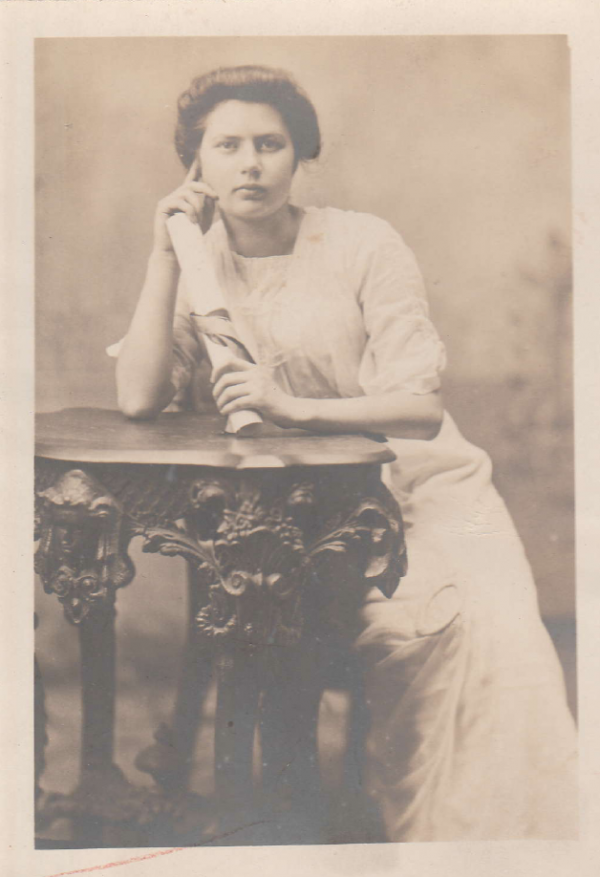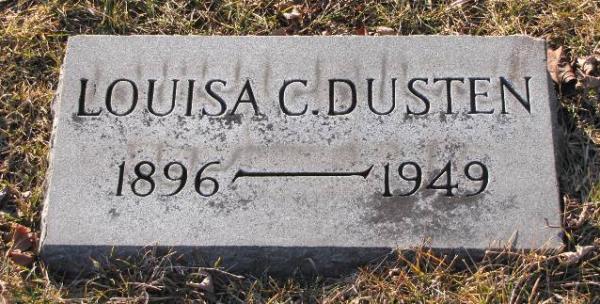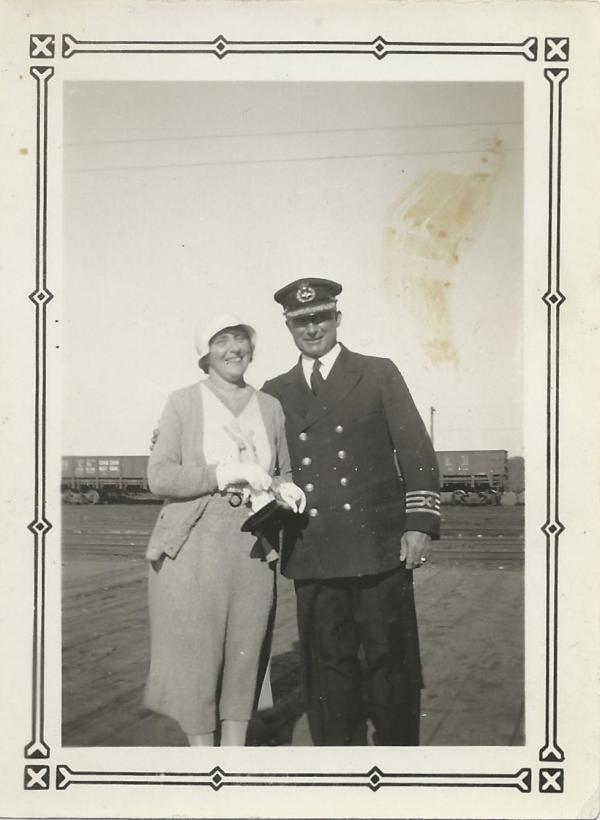
September 2014 marked the 65th anniversary of the violent passing of a landmark that was never “anchored” in St. Clair Township. It was in the early morning hours of Sat. Sept. 17, 1949 that a floating landmark with strong ties to Moore and Sombra Townships was lost forever. The passenger ship S. S. Noronic was destroyed by fire in the early morning hours of Sat. Sept. 17th while it was docked at the old Pier 9 in Toronto harbour. Of the 524 passengers on board, 119 died.
The lives of two of the company’s employees who were residents of the townships were tragically affected. The disaster claimed the life of Miss Louisa C. Dusten, a resident of Sarnia with strong family ties to Sombra, who had worked for the company for thirty years and had served as its capable and respected paymistress. Capt. William Taylor, the ship’s master who lived in Mooretown and had begun his 47-year old sailing career on the St. Clair River, resigned from the company and never sailed again.
The Noronic affectionately belonged to everyone along the Great Lakes and their connecting rivers. Her nickname was the “Queen of the Lakes”. But, it was to the people of Sarnia and Lambton County that the passenger ships held special meaning. Point Edward and Sarnia were the home ports of the Northern Navigation Division of the Canada Steamship Lines (C.S.L.). Many local people worked on the ships or for the company. Many had begun their employment as deckhands or clerks and had been able to gain responsible positions with an income to match.
Miss Dusten and Capt. Taylor were two examples out of many from the township who worked for the Northern Navigation Division.
The Fire
Capt. Taylor, like nearly his entire crew, had also left the ship on the Friday evening. He visited friends in their home in the Russell Hill neighbourhood of Toronto and had taken a taxi back to the ship. He had returned to the ship and the officers’ quarters at 2:25 a.m. At 2:30 a.m., the fire was discovered by a passenger who noticed smoke coming from a linen closet on the “C” deck of the Noronic. At 2:38 a.m., one of the bellboys who had, along with the same passenger, tried to extinguish the flames informed the wheelsman that there was a serious fire. Even before the crew knew that the ship was on fire, the security police officer at the pier saw flames onboard. At 2:34 a.m., he phoned in the call to the fire and police departments.
The wheelsman frantically shouted at Capt. Taylor that there was a fire as the wheelsman raced by him to inform the First Officer. Capt. Taylor tried to fight the fire, then realized that it was hopeless. He ran from bow to stern shouting to arouse people from sleep. Within the few frenzied minutes that he was onboard, he picked up hoses as he raced along the corridors trying unsuccessfully to find one with sufficient water pressure to battle the inferno. At other times, he smashed cabin windows calling out for people to abandon ship. At one point, he landed safely on the pier. But, the thought of being able to save even just one more person compelled him to break free from those who were trying to restrain him. Capt. Taylor entered a freight door, proceeded through the engine room and succeeded in reaching the bow. The fire cornered him and a passenger. If it had not been for the quick response of two firemen who swung an extension ladder to them, both would likely have been burned to death. As the two men were climbing down, the ladder broke and they were pitched into the harbour. But, a police detective who had commandeered a boat rescued them.
At 2:41 a.m., the first engine of the Toronto Fire Department arrived just 3 minutes after Captain Taylor had been informed of the fire. Even before the fire chief reached the scene, the height of the flames caused him to authorize response to a 3-alarm fire, which ordered into action 16 more rigs and Toronto harbour’s two fire boats. But, the fire was beyond suppression. The ship with its lemon-oil-polished corridors of panelling had exploded into an inferno. The water that was aimed into the ship from the fire engines vapourized before it even hit the hull. Shortly after 3:00 a.m., everyone who would either leave the ship or die on it had done so.
Miss Louisa Clarissa Dusten

Miss Dusten was born in 1896 in Clare, Michigan after her parents had moved there from Sombra. She later returned to Ontario and worked in the accounting department of the Canada Steamship Lines office in Point Edward. She became the company’s paymistress and was described as being well-loved and conscientious. The ironic tragedy was that she had received the end of season passage as a gift to her from the company in recognition of her 30th year of service. But, due to her diligent nature, she had taken along the payroll ledgers so that she could keep them up to date.
On the night of the fire, Miss Dusten had taken a break so that she and Nellie Burr, a fellow employee, could visit “Nick” Nicholson, on the passenger ship, Cayuga, which was berthed nearby. Miss Dusten and Mrs. Burr had known Nick from when he had worked as the purser of the Noronic in the early 1940s.

Both women were alerted to the fire by an agitated Sam Graham, another employee, who had been asleep on the Noronic at the time of the fire. He fled the ship in such a state of panic that he left his trousers in his cabin. Sam scrambled onboard the Cayuga to find an extra pair of coveralls in the ship’s supplies. 1 After being notified about the fire, Miss Dusten and Mrs. Burr raced back and boarded the doomed ship – Miss Dusten to dutifully rescue her payroll ledgers and Mrs. Burr to rouse and save her daughter, Iva, who was asleep in their cabin. 2 All three women narrowly escaped, but unlike Mrs. Burr and Iva, Miss Dusten was burned.
Miss Dusten seemed to make good progress from the burns that covered 40 per cent of her body. However, it was only fleeting. Miss Dusten died three weeks later — the lone Canadian casualty of the S.S Noronic fire. Her funeral was conducted at Central United Church, Sarnia and she was buried in Riverside Cemetery, north of Sombra where her family had lived. Her gravestone rests beside those of her parents and the one for her two young sisters.


Capt. William Taylor
Capt. Taylor was born in Waubuno, Moore Township on Sept. 1, 1883. He began his maritime career in 1902 as an 18-year old wheelsman onboard the M. Sicken, a wooden-hulled steam barge built in Marine City, Michigan in 1884, owned by Matt Sicken of Marine City, Michigan (who also owned the Sicken Lumber Company of Marine City, Mich. and Sombra, Ont.). He served on many ships and worked his way up through the ranks until he acquired his master’s papers in 1932. By 1934, he was serving as the master of the S. S. Huronic, one of the two sister ships of the Noronic. In fact, throughout his career, he commanded all three sister passenger ships because he had also served as the master of the S. S. Hamonic. (The Hamonic is remembered locally as the ship destroyed in a disastrous fire at the C.S.L. sheds in Point Edward on July 17, 1945 with no loss of life to either passengers or crew. The crew was credited with their immediate response to the orders of the quick-witted Capt. Horace Beaton). Within a few years, the company selected Capt. Taylor as the master of their flagship, the Noronic.
As the captain, much of his responsibility involved cultivating a good rapport with the ship’s clientele. As one reads the dozens of cards and letters that he received after the fire, one gets the impression that he made a meaningful one on the many passengers (a high percentage of his sympathizers and admirers were women!).
An able seafarer and an adept host, Capt. Taylor may not have been gifted in the art of our current generation’s preoccupation with health and safety. On the night of the tragic fire, Capt. Taylor (very likely with the full knowledge of the company) had knowingly or unknowingly approved of a plan in which only a minimal staff complement remained on board ship. Only 15 of its 171 crew members were on duty for a passenger roster that numbered 524. Following the fire, this circumstance loomed large when it was made known that not a single member of the crew died in the fire. All crew members on duty had managed to scramble to safety – some assisting passengers and others just concentrating on abandoning the ship. The Court of Investigation convened 11 days after the disaster and lasted five weeks. Its findings indicated that Capt. Taylor and the company had not taken proper precautions for the safety of the passengers in the event of such a tragedy. Fire drill procedures were practised only by the crew. The company felt that vacationing passengers should not be bothered with the annoying interruption of emergency drills.
The Court’s report was damning of Capt. Taylor’s lack of emergency preparedness and berated his judgment. The Court determined that Capt. Taylor should have anticipated the potential for disaster “had he really applied his mind to the situation”.
Consequently, his certificate was ordered to be suspended for one year. He never asked for it to be re-instated. The General Manager of the Canada Steamship Lines provided his assessment of the enquiry and his confidence in Capt. Taylor’s proficiency. In a letter marked “Personal and Confidential” dated Dec. 7, 1949 from (Capt.) Norman J. Reoch, General Manager of C.S.L., from the company headquarters in Montreal, Quebec, to Capt. Taylor he wrote:
No doubt, you have read a copy of Mr. Justice Kellock’s report, with interest, but after witnessing the way the trial was conducted in Toronto by men who knew absolutely nothing regarding the ship, such findings cannot be taken too seriously by seafaring men. However, I am sorry that he saw fit to take away your license until next Fall and the purpose of this letter is to tell you that you will be retained on the Company’s payroll, for the Season of 1950, at the same salary you received while sailing the Steamer “NORONIC”.
Capt. Taylor returned to this area to live, although not in the historic home that he owned in Mooretown. (This home was built in 1825 by James Francis Bâby and remains Lambton County’s oldest building.) He ended his days working as the desk clerk at McFee’s Hotel at the northwest corner of Cromwell and Victoria Streets in downtown Sarnia. He lived in an apartment in Sarnia for the remainder of his life. He died on Feb. 17, 1962 and was buried in Bear Creek Cemetery on Moore Line. For a few years after Capt. Taylor’s death, his wife, Harriett (Hattie), continued to live in their home in Mooretown. Hattie died on Jan. 22, 1970 at the Gloria Gogins Nursing Home and was buried in St. Joseph’s Cemetery, Corunna.

Friends of Capt. Taylor knew that the man who was highly regarded by his employer, his colleagues and many of his passengers never fully recovered from the night that the “Queen of the Lakes” died along with 119 of her passengers.
The Aftermath
The loss of the Noronic closed a chapter in Great Lakes history. After the Noronic disaster, Canadian passenger ship guidelines were drastically changed. Only a few ships met the requirements. Rather than bear costly retrofitting in an age when interest in Great Lakes cruising was quickly disappearing, the passenger ships were quickly laid up and eventually scrapped. The last surviving Canadian Great Lakes passenger steamship (the Keewatin re-patriated in June, 2012 from Douglas, Michigan to Port McNicoll, Ont.) was retired from passenger service in 1965. The American passenger ships did not last much longer due to equivalent restrictive requirements. One of the last and a favourite among shipwatchers along the St. Clair River was the S. S. South American which retired from service in 1967.
A commemorative plaque is located near the site of the tragedy just west of the Westin Harbour Castle Hotel in Toronto. The Toronto harbourfront has changed dramatically throughout the years with tons of fill that has reclaimed some of the harbour and its old shipping piers. On the night of the tragedy on Sept. 17, 1949, the Noronic was tied at Pier 9 with her bow in the same spot as the present lobby of the hotel.
For further reading, see John Craig’s, The Noronic is Burning.
Notes:
1 Sam Graham, a resident of Point Edward, was a truck driver for the Canada Steamship Lines. He had delivered badly needed supplies such as fresh fruits and vegetables from the C.S.L. yards in Point Edward to the company sheds on Pier 9. Owing to the fact that the truck would not be unloaded until the morning, he was told to spend the night in one of the unoccupied passenger cabins. He was assigned one of the unoccupied cabins on ‘C’ Deck – half way between the linen closet where the fire originated and the bar. Shortly after falling asleep, he was awakened by loud noises and even louder voices outside his cabin. “. . . he stuck his head out of the door to see just what was going on. It was nearly his last look, as a ball of fire shot by his head, searing his hair and nearly scaring him out of his wits”. (Garrett, pg. 71) He hurried along the corridor and exited at the bar door at the stern of ‘C’ deck. As he proceeded along the outside deck towards the mid-ship doors and onto the dock, he passed many passengers laughing and pointing at him. Sam would later understand the explanation for their humour. In the meantime, his primary focus had been to move his truck out of the way for the fire trucks. It was only when he reached down to get the keys out of his pocket that he realized that there were no keys, no pocket, and no trousers! This explains his hurried and harried trip to the Cayuga during which he alerted Miss Dusten and Mrs. Burr about the fire.
2 Mrs. Nellie Burr* and her daughter, Iva Coates*, residents of Point Edward, had received discounted fares for the last cruise of the season. But, Nellie and Iva had a great advantage over Miss Dusten. As an office employee, Miss Dusten would have had very few occasions to visit any of the ships. On the other hand, Nellie and Iva would have regularly visited the passenger ships. They were both employed in the Canada Steamship Lines’ laundry which was located in a building in Point Edward beside the old fish hatchery. They would have routinely stocked the passenger ships with fresh linens and would have been very familiar with the passageways. Mrs. Nellie Burr recalled that she had just saved up and purchased a brown skirt suit in preparation for the cruise on the Noronic. On the night of the fire, Nellie had also been visiting crew members of the Cayuga, as had Miss Dusten. Sam Graham, a Canada Steamship Lines employee who had been onboard the Noronic, rushed over to tell them that he had just narrowly escaped the fire. Nellie returned to the ship to wake and rescue her daughter, Iva, from the burning ship. After she and Iva were safely on the pier platform, she realized that she only had time to grab her suit jacket. She assumed that she had forgotten to grab her skirt in their haste to escape the inferno. When she looked down at her arm, there was the skirt draped over it. In her state of panic, she had no recollection of grabbing or clutching the skirt. (* Great aunt and cousin of Laurie Mason, curator of Moore Museum.) ] 2
Sources:
Craig, John. The Noronic is Burning! Don Mills, Ont.: General Publishing Co. Limited, 1976.
Garrett, Doug. Along the Lakes. Sarnia, Ont.: Haines Printing Co., [1970].

